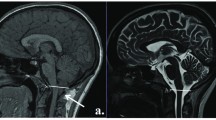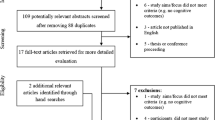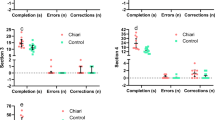Abstract
Chiari Malformation type I (CM-I) is a neurological disorder characterized by a displacement of the cerebellar tonsils through the foramen magnum into the spinal canal. Most research has focused on physical symptomatology but few studies include neuropsychological examinations. Moreover, although current research highlights the involvement of the cerebellum on higher cognitive functions, little is known about cognitive consequences associated with CM-I. The aim of this study is to analyze cognitive functioning between 39 CM-I patients and 39 healthy controls, matched by gender, age and years of education. Participants have been examined on a large battery of neuropsychological tests, including executive functioning, verbal fluency, spatial cognition, language, verbal memory, processing speed, facial recognition and theory of mind. Results show a poorer performance of the clinical group compared to the control group, even after controlling the effect of physical pain and anxious-depressive symptomatology. The findings suggest the presence of a generalized cognitive deficit associated with CM-I, which makes it necessary to focus attention not only on physical consequences, but also on cognitive ones.


Similar content being viewed by others
References
Manto M, Christian H. Chiari malformations. In: Manto M, Gruol DL, Schmahmann JD, Koibuchi N, Rossi F, editors. Handbook of the cerebellum and cerebellar disorders. Dordrecht: Springer; 2013. p. 1873–85. https://doi.org/10.1007/978-94-007-1333-8.
Mariwalla NR, Boydston WR, Chern JJ. Newer subsets: Chiari 0 and Chiari 1.5 malformations. In: Tubbs RS, Oakes WJ, editors. The Chiari malformations. New York: Springer; 2013. p. 241–6. https://doi.org/10.1007/978-1-4614-6369-6_2.
Tubbs RS, Oakes WJ. Introduction and classification of the Chiari malformations. In: Tubbs RS, Oakes WJ, editors. The Chiari malformations. New York: Springer; 2013. p. 1–3. https://doi.org/10.1007/978-1-4614-6369-6_2.
Tubbs RS, Oakes WJ. The Chiari malformations: a historical context. In: Tubbs RS, Oakes WJ, editors. The Chiari malformations. New York: Springer; 2013. p. 5–11. https://doi.org/10.1007/978-1-4614-6369-6_2.
Urbizu A, Toma C, Poca MA, Sahuquillo J, Cuenca-León E, Comand B, et al. Chiari malformation type I: a case-control association study of 58 developmental genes. PLoS One. 2013;8:e57241. https://doi.org/10.1371/journal.pone.0057241.
Öktem H, Dilli A, Kürkçüoglu A, Soysal H, Yazici C, Pelin C. Prevalence of Chiari type I malformation on cervical magnetic resonance imaging: a retrospective study. J Exp Clin Anat. 2016;10:40–5. https://doi.org/10.2399/ana.15.039.
Amado ME, Avellaneda A, Barrón J, Chesa E, De la Cruz J, Escribano M, et al. Malformaciones de la Unión Cráneo-Cervical (Chiari tipo I y Siringomielia). Documento de Consenso. Madrid: Editorial Médica A.W.W.W.E. S.A.; 2009.
deSouza RM, Zador Z, Frim DM. Chiari malformation type I: related conditions. Neurol Res. 2011;33:278–84. https://doi.org/10.1179/016164111X12962202723922.
Meadows J, Guarnieri M, Miller K, Haroun R, Kraut M, Carson BS. Type I Chiari malformation: a review of the literature. Neurosurg Q. 2001;11(3):220–9.
Chen J, Li Y, Wang T, Gao J, Xu J, Lai R, et al. Comparison of posterior fossa decompression with and without duraplasty for the surgical treatment of Chiari malformation type I in adult patients. Medicine. 2017;96:e5945. https://doi.org/10.1097/MD.0000000000005945.
Leiner HC, Leiner AL, Dow RS. Does the cerebellum contribute to mental skills? Behav Neurosci. 1986;100(4):443–54.
Bodranghien F, Bastian A, Casali C, Hallett M, Louis ED, Manto M, et al. Consensus paper: revisiting the symptoms and signs of cerebellar syndrome. Cerebellum. 2016;15:369–91. https://doi.org/10.1007/s12311-015-0687-3.
Koziol LF, Budding D, Andreasen N, D’Arrigo S, Bulgheroni S, Imamizu H, et al. Consensus paper: the cerebellum’s role in movement and cognition. Cerebellum. 2014;13:151–77. https://doi.org/10.1007/s12311-013-0511-x.
Habas C. Functional imaging of the deep cerebellar nuclei: a review. Cerebellum. 2010;9:22–8. https://doi.org/10.1007/s12311-009-0119-3.
Tirapu J, Luna P, Iglesias MD, Hernáez P. Contribución del cerebelo a los procesos cognitivos: avances actuales. Rev Neurol. 2011;53(5):301–15.
Voogd J. The human cerebellum. J Chem Neuroanat. 2003;26(4):243–52.
Stoodley CJ. The cerebellum and cognition: evidence from functional imaging studies. Cerebellum. 2012;11:352–65. https://doi.org/10.1007/s12311-011-0260-7.
Stoodley CJ, Valera EM, Schmahmann JD. Functional topography of the cerebellum for motor and cognitive tasks: an fMRI study. NeuroImage. 2012;59:1560–70. https://doi.org/10.1016/j.neuroimage.2011.08.065.
Steinlin M, Wingeier K. Cerebellum and cognition. In: Manto M, Gruol DL, Schmahmann JD, Koibuchi N, Rossi F, editors. Handbook of the cerebellum and cerebellar disorders, vol. 2013. Dordrecht: Springer; 2013. p. 1687–99. https://doi.org/10.1007/978-94-007-1333-8.
Schmahmann JD, Sherman JC. The cerebellar cognitive affective syndrome. Brain. 1998;131(4):561–79.
Leggio MG, Silveri MC, Petrosini L, Molinari M. Phonological grouping is specifically affected in cerebellar patients: a verbal fluency study. J Neurol Neurosurg Psychiatry. 2000;69(1):102–6.
Gottwald B, Wilde B, Mihajlovic Z, Mehdorn HM. Evidence for distinct cognitive deficits after focal cerebellar lesions. J Neurol Neurosurg Psychiatry. 2004;75:1524–31. https://doi.org/10.1136/jnnp.2003.018093.
Molinari M, Leggio MG. Cerebellar information processing and visuospatial functions. Cerebellum. 2007;6:214–20. https://doi.org/10.1080/14734220701230870.
Leggio MG, Tedesco AM, Chiricozzi FR, Clausi S, Orsini A, Molinari M. Cognitive sequencing impairment in patients with focal or atrophic cerebellar damage. Brain. 2008;131:1332–43. https://doi.org/10.1093/brain/awn040.
Strick PL, Dum RP, Fiez JA. Cerebellum and nonmotor function. Annu Rev Neurosci. 2009;32:413–34. https://doi.org/10.1146/annurev.neuro.31.060407.125606.
Koziol LF, Barker LA. Hypotonia, jaundice, and Chiari malformations: relationships to executive functions. Appl Neuropsychol. 2013;2:141–9. https://doi.org/10.1080/21622965.2013.748390.
D’Angelo E, Casali S. Seeking a unified framework for cerebellar function and dysfunction: from circuit operations to cognition. Front Neural Circ. 2013; https://doi.org/10.3389/fncir.2012.00116.
Mariën P, Ackermann H, Adamaszek M, Barwood CHS, Beaton A, Desmond J, et al. Consensus paper: language and the cerebellum: an ongoing enigma. Cerebellum. 2014; https://doi.org/10.1007/s12311-013-0540-5.
Nakamoto FK, Tsutsumiuchi M, Maeda MH, Uesaka Y, Takeda K. Memory impairment following right cerebelar infarction: a case study. Neurocase. 2015;21:660–4. https://doi.org/10.1080/13554794.2014.969277.
Van Overwalle F, Mariën P. Functional connectivity between the cerebrum and cerebellum in social cognition: a multi-study analysis. NeuroImage. 2016;124:248–55. https://doi.org/10.1016/j.neuroimage.2015.09.001.
Allen PA, Houston JR, Pollock JW, Buzzelli C, Li X, Harrington AK, et al. Task-specific and general cognitive effects in Chiari malformation type I. PLoS One. 2014;9(4):1–11. https://doi.org/10.1371/journal.pone.0094844.
Kumar M, Rathore RK, Srivastava A, Yadav SK, Behari S, Gupta RK. Correlation of diffusion tensor imaging metrics with neurocognitive function in Chiari I malformation. World Neurosurg. 2011;76:189–94. https://doi.org/10.1016/j.wneu.2011.02.022.
Riva D, Usilla A, Saletti V, Esposito S, Bulgheroni S. Can Chiari malformation negatively affect higher mental functioning in developmental age? Neurol Sci. 2011;32:307–9. https://doi.org/10.1007/s10072-011-0779-x.
Novegno F, Caldarelli M, Massa A, Chieffo D, Massimi L, Pettorini B, et al. The natural history of the Chiari type I anomaly. J Neurosurg Pediatr. 2008;2:179–87. https://doi.org/10.3171/PED/2008/2/9/179.
Lacy M, Ellefson SE, DeDios-Stern S, Frim DM. Parent-reported executive dysfunction in children and adolescents with Chiari malformation type 1. Pediatr Neurosurg. 2016;51:236–43. https://doi.org/10.1159/000445899.
Mestres O, Poca MA, Solana E, Radoi A, Quintana M, Force E, et al. Evaluación de la calidad de vida en los pacientes con una malformación de Chiari tipo I. Estudio piloto en una cohorte de 67 pacientes. Rev Neurol. 2012;55(3):148–56.
Wilson BA, Alderman N, Burgess PW, Emslie H, Evans JJ. Behavioral assessment of the dysexecutive syndrome. England: Thames Valley Test Company; 1996.
Vargas ML, Sanz JC, Marín JJ. Behavioral assessment of the dysexecutive syndrome battery (BADS) in schizophrenia. A pilot study in the Spanish population. Cogn Behav Neurol. 2009;22(2):95–100.
Wechsler D. Wechsler adult intelligence scale, 4th ed. WAIS-IV. San Antonio: Pearson; 2008.
Wechsler D. WAIS-IV. Escala de inteligencia de Wechsler para adultos-IV. Madrid: NCS Pearson; 2012.
Golden CJ. Stroop color and word test. Chicago: Stoelting; 1978.
Golden CJ. Stroop Test de Colores y Palabras. Madrid: TEA Ediciones; 2010.
Benton AL, Hamsher K. Multilingual aplasia examination. Iowa City: Department of Neurology and Psychology, The University of Iowa; 1989.
Strauss E, Sherman EMS, Spreen O. A compendium of neuropsychological tests. New York: Oxford University Press; 2006.
Osterrieth PA. Le test de copie d’une figure complexe: Contribution à l’étude de la perception et la mémoire. Arch Psychol. 1944;30:286–356.
Rey A. L’examen psychologique dans les cas d’encéphalopathie traumatique. Arch Psychol. 1941;28:286–340.
Rey A. Test de Copia de una Figura Compleja. Madrid: TEA Ediciones; 1980.
Kaplan E, Goodglass H, Weintraub S. Boston naming test. Philadelphia: Lippincott Williams and Wilkins; 2001.
Kaplan E, Goodglass H, Weintraub S. Test de Denominación de Boston. Madrid: Panamericana; 2005.
Benedet MJ, Alejandre MA. TAVEC Test de Aprendizaje Verbal España-Complutense. Madrid: TEA Ediciones, S.A; 1998.
Smith A. Symbol digits modalities test. Western Psyhological Services: Los Angeles; 1982.
Smith A. Test de símbolos y dígitos. Madrid: TEA Ediciones; 2002.
Benton AL, Sivan AB, Hamsher KS, Varney NR, Spreen O. Contributions to neuropsychological assessment. New York: Oxford University Press; 1994.
Escanilla A. Datos normativos piloto de una población española de tres pruebas visuales de Benton: reconocimiento facial, orientación de líneas y discriminación de formas. Psychiatry and Legal Medicine Department. Autonomous University of Barcelona; 2000.
Kessler H, Bayerl P, Deighton RM, Traue HC. Facially Expressed Emotion Labeling (FEEL): PC-gestützer Test zur Emotionserkennung. Verhaltenstherapie und Verhaltensmedizin. 2002;23(3):297–306.
Lázaro E, Amayra I, López-Paz JF, Martínez O, Pérez M, Berrocoso S, et al. Instrument for assessing the ability to identify emotional facial expressions in healthy children and in children with ADHD: the FEEL test. J Atten Disord. 2016; https://doi.org/10.1177/1087054716682335.
Happé F. An advanced test of theory of mind: understanding of story characters’ thoughts and feelings by able autistic, mentally handicapped, and normal children and adults. J Autism Dev Disord. 1994;24:129–54.
Pousa E. Measurement of theory of mind in healthy adolescents: translation and cultural adaptation of F. Happé’s theory of mind stories (1999). Health Psychology and Social Psychology Department. Autonomous University of Barcelona; 2002.
Zigmond A, Snaith R. The hospital anxiety and depression scale. Acta Psychiatr Scand. 1983;67:361–70.
López-Roig S, Terol M, Pastor M, Neipp M, Massutí B, Rodríguez-Marín J, et al. Ansiedad y Depresión. Validación de la escala HAD en pacientes oncológicos. J Health Psychol. 2002;12(2):127–55.
Downie WW, Leatham PA, Rhind VM, Wright V, Branco JA, Anderson JA. Studies with pain rating scales. Ann Rheum Dis. 1978;37(4):378–81.
Haelferi M, Elfering A. Pain assessment. Eur Spine J. 2006;15:S17–24. https://doi.org/10.1007/s00586-005-1044-x.
Habas C, Kamdar N, Nguyen D, Prater K, Beckman CF, Menon V. Distinct cerebellar contributions to intrinsic connectivity networks. J Neurosci. 2009;29:8586–94. https://doi.org/10.1523/JNEUROSCI.1868-09.2009.
Garrard P, Martin NH, Giunti P, Cipolotti L. Cognitive and social cognitive functioning in spinocerebellar ataxia. J Neurol. 2008;2008:398–405. https://doi.org/10.1007/s00415-008-0680-6.
Courchesne E, Yeung-Courchesne R, Press GA, Hesselink JR, Jernigan TL. Hypoplasia of cerebellar vermal lobules VI and VII in autism. N Engl J Med. 1988;318:1349–54. https://doi.org/10.1056/NEJM198805263182102.
Ozguven HD, Oner O, Baskak B, Oktem F, Olmez S, Munir K. Theory of mind in schizophrenia and Asperger’s syndrome: relationship with negative symptoms. Klinik Psikofarmakol Bulteni. 2010;20(1):5–13.
Tirapu J, Pérez G, Erekatxo M, Pelegrín C. Qué es la teoría de la mente? Rev Neurol. 2007;44(8):479–89.
Ferrucci R, Giannicola G, Rosa M, Fumagalli M, Boggio PS, Hallett M, et al. Cerebellum and processing of negative facial emotions: cerebellar transcranial DC stimulation specifically enhances the emotional recognition of facial anger and sadness. Cognit Emot. 2012;26:786–99. https://doi.org/10.1080/02699931.2011.619520.
D’Agata F, Caroppo P, Baudino B, Caglio M, Croce M, Berqui M, et al. The recognition of facial emotions in spinocerebellar Ataxia patients. Cerebellum. 2011;10:600–10. https://doi.org/10.1007/s12311-011-0276-z.
Eshetu T, Meoded A, Jallo GI, Carson BS, Huisman TA, Poretti A. Diffusion tensor imaging in pediatric Chiari type I malformation. Dev Med Child Neurol. 2014;56:742–8. https://doi.org/10.1111/dmcn.12494.
Snell RS. El cerebelo y sus conexiones. In: Snell RS, editor. Neuroanatomía clínica. Madrid: Editorial Médica Panamericana; 2007. p. 243–65.
Krishna V, Sammartino F, Yee P, Mikulis D, Walker M, Elias G, et al. Diffusion tensor imaging assessment of microstructural brainstem integrity in Chiari malformation type I. J Neurosurg. 2016;125:1112–9. https://doi.org/10.3171/2015.9.JNS151196.
Akar E, Kara S, Akdemir H, Kɪrɪş A. Fractal dimension analysis of cerebellum in Chiari malformation type I. Comput Biol Med. 2015; https://doi.org/10.1016/j.compbiomed.2015.06.024.
Akar E, Kara S, Akdemir H, Kɪrɪş A. 3D structural complexity analysis of cerebellum in Chiari malformation type I. Med Biol Eng Comput. 2017;55:2169–82. https://doi.org/10.1007/s11517-017-1661-7.
Kraan C. Cerebellar cognitive affective syndrome. In: Rinehart N, Bradshaw J, Enticott P, editors. Developmental disorders of the brain. New York: Routledge; 2017. p. 25–43.
Tedesco AM, Chiricozzi FR, Clausi S, Lupo M, Molinari M, Leggio MG. The cerebelar cognitive profile. Brain. 2011;134:3672–86. https://doi.org/10.1093/brain/awr266.
Schmahmann JD. (1991). An emerging concept. The cerebellar contribution to higher function. Arch Neurol. 1991;48(11):1178–87.
Noroozian M. The role of the cerebellum in cognition: beyond coordination in the central nervous system. Neurol Clin. 2014;32:1081–104. https://doi.org/10.1016/j.ncl.2014.07.005.
Schmahmann JD. Disorders of the cerebellum: ataxia, dysmetria of thought, and the cerebellar cognitive affective syndrome. J Neuropsychiatry Clin Neurosci. 2004;16:367–78. https://doi.org/10.1176/jnp.16.3.367.
Acknowledgements
We thank ANAC, ChySPA, and all of participants for their involvement in the study.
Funding
This study was funded by a grant of the Education Department of the Basque Government’s “Programa Predoctoral de Formación de Personal Investigador No Doctor” [PRE_2016_1_0099 to Maitane García].
Author information
Authors and Affiliations
Corresponding author
Ethics declarations
Conflict of Interest
The co-authors declare that they have no conflict of interest.
Ethical Approval and Informed Consent
The study was developed in accordance with ethical standards and with the 1964 Helsinki declaration and its later amendments. Informed consent was obtained from all individual participants included in the study.
Rights and permissions
About this article
Cite this article
García, M., Lázaro, E., López-Paz, J.F. et al. Cognitive Functioning in Chiari Malformation Type I Without Posterior Fossa Surgery. Cerebellum 17, 564–574 (2018). https://doi.org/10.1007/s12311-018-0940-7
Published:
Issue Date:
DOI: https://doi.org/10.1007/s12311-018-0940-7




